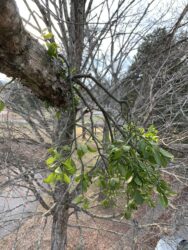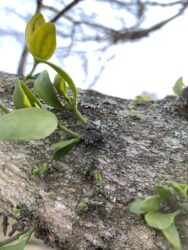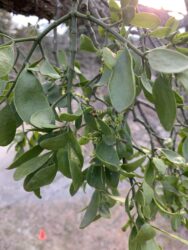By Bernheim
 The visual impact of deciduous trees abound in our landscape during late fall and winter. Looking up and being able to see the structure of a tree can be awe-inspiring. As my eyes follow the trunk from ground to sky, I notice the many side branches as they flow from coarse to fine. The differing bark textures and patterns are more pronounced. The little nuances like grooves along a branch’s bark, and even patches of green growth randomly scattered throughout the canopy. It is fun to see what the tree has been hiding behind its leaves, with this last observation usually leading to questions.
The visual impact of deciduous trees abound in our landscape during late fall and winter. Looking up and being able to see the structure of a tree can be awe-inspiring. As my eyes follow the trunk from ground to sky, I notice the many side branches as they flow from coarse to fine. The differing bark textures and patterns are more pronounced. The little nuances like grooves along a branch’s bark, and even patches of green growth randomly scattered throughout the canopy. It is fun to see what the tree has been hiding behind its leaves, with this last observation usually leading to questions.
Mistletoe is responsible for making many do a double-take and ask the question, “What is that growing that tree, and how did it get there?”. When most hear the word mistletoe, the first thing that comes to mind is getting a kiss under it from the dreamiest person imaginable. This is a very festive tradition that has persisted since the 1500’s. It is said that each berry is a kissing wish and once all the berries are gone, so go the wishes. When I was young, I recall going to a family holiday party and mistletoe was hung in a doorway. It was artificial, so I wonder if that meant endless wishes. In any event, that was my first introduction to the mistletoe folklore. Being able to see living mistletoe and learning about its benefits to the environment have been very interesting.
 There are an estimated 36 species of mistletoe native to North America, with Phoradendron serotinum being the species most prevalent in Kentucky. Most are known for their white berries, but I have seen hues of white/orange berries in Arizona. The word mistletoe comes from Old English and has gone through several iterations to mean “dung twig”. How did we go from kissing to dung? Simple, bird poop. Birds devour the ripe berries and indiscriminately perch on tree branches, and poop. This natural body function deposits the seed with enough water for germination. The seed catches in the grooves of the branch and roots begin to germinate, piercing into the bark. A slender growth, also called a haustorium, begins to emerge, followed by leaves, and eventually those signature kissing wishes (the white berries).
There are an estimated 36 species of mistletoe native to North America, with Phoradendron serotinum being the species most prevalent in Kentucky. Most are known for their white berries, but I have seen hues of white/orange berries in Arizona. The word mistletoe comes from Old English and has gone through several iterations to mean “dung twig”. How did we go from kissing to dung? Simple, bird poop. Birds devour the ripe berries and indiscriminately perch on tree branches, and poop. This natural body function deposits the seed with enough water for germination. The seed catches in the grooves of the branch and roots begin to germinate, piercing into the bark. A slender growth, also called a haustorium, begins to emerge, followed by leaves, and eventually those signature kissing wishes (the white berries).
It is hard to believe that a plant with this much folklore could be hemiparasitic. Mistletoe lives off the nutrient resources of its gracious host, the tree, until it has produced enough leaves for photosynthesis. An over abundance of mistletoe in a tree can lead to canopy dieback and even severe decline. Even the most gracious hosts have their limits. The berries may be a food source for birds and mammals, except for humans. Human ingestion will cause blurred vision and nausea, so it is a good thing folklore did not say eat the berry to get the kissing wish. If that were the case, we would be calling beer goggles “mistletoe goggles”.
 All kidding aside, mistletoe is part of nature. Its value and purpose are multifold in the animals it serves through food, and the nesting habitat provided from its dense growth form. To some it is a nuisance, but I see this wonderful native plant that plays an important role in the cycle of nature. If you are fortunate enough this Holiday season to be the tree in this scenario, my hope is that you will let a little mistletoe into your life and share your abundance. Who knows, you may even be rewarded with a kiss.
All kidding aside, mistletoe is part of nature. Its value and purpose are multifold in the animals it serves through food, and the nesting habitat provided from its dense growth form. To some it is a nuisance, but I see this wonderful native plant that plays an important role in the cycle of nature. If you are fortunate enough this Holiday season to be the tree in this scenario, my hope is that you will let a little mistletoe into your life and share your abundance. Who knows, you may even be rewarded with a kiss.

